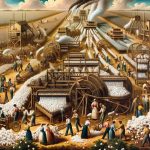Are you curious about how cotton fabric is made?
In this step-by-step timeline, you’ll discover the fascinating process of producing cotton fabric from start to finish.
From the harvesting and cleaning of the cotton to the spinning and yarn production, followed by weaving and fabric formation, and finally, the finishing touches and quality control.
Get ready to delve into the world of cotton fabric production and gain a deeper understanding of this essential textile.
Table of Contents
Harvesting and Cleaning
To begin the process of cotton fabric production, you’ll first harvest the cotton and then clean it.
Cotton picking is the initial step in obtaining raw cotton fibers. It involves carefully plucking the cotton bolls from the plants by hand or using mechanical cotton pickers.
Once the cotton has been harvested, the next step is fiber processing. This involves separating the cotton fibers from the seeds and other impurities.
The harvested cotton is taken to a cotton gin, where it undergoes a series of mechanical processes to remove the unwanted elements. The cotton fibers are pulled away from the seeds through a process called ginning, which involves the use of revolving saws or rollers.
The ginned cotton is then cleaned further to remove any remaining impurities, such as dirt, leaves, or small sticks. This is done using a combination of air blasts, screens, and magnets.
The cleaned cotton fibers are now ready to be processed further into yarn, which is the next step in the cotton fabric production process.
Ginning and Separating
After the cotton has been harvested and cleaned, the next step in the cotton fabric production process involves ginning and separating the fibers from the seeds and other impurities.
To fully understand the ginning process and separating techniques used, consider the following:
-
Ginning process
-
The cotton is fed into a ginning machine, which separates the fibers from the seeds.
-
The machine uses rotating saws or teeth to pull the fibers away from the seeds, leaving behind the cotton lint.
-
Separating techniques
-
One common separating technique is called ‘ginning by roller.’ In this method, the cotton is passed through a series of rollers that remove the seeds and impurities.
-
Another technique is ‘saw ginning,’ where a rotating saw blade pulls the fibers away from the seeds. This process is more common in larger operations.
These ginning and separating techniques are crucial in preparing the cotton fibers for the next step in the fabric production process. By effectively removing the seeds and impurities, the cotton lint is ready to be further processed into yarn and eventually transformed into the soft and comfortable cotton fabric we all know and love.
Spinning and Yarn Production
Once the cotton fibers have been ginned and separated, it’s time to move on to spinning and yarn production. This crucial step involves transforming the loose cotton fibers into strong and durable yarn, ready to be woven into fabric. Spinning techniques play a vital role in determining the quality and characteristics of the final yarn.
There are two main spinning techniques commonly used in cotton fabric production: ring spinning and open-end spinning. Ring spinning is known for producing high-quality yarn with excellent strength and uniformity. It involves twisting the cotton fibers together using a spinning frame and a spindle. On the other hand, open-end spinning is a faster and more economical method that produces bulkier yarn. It utilizes a rotor spinning machine to spin the cotton fibers, resulting in a slightly less uniform yarn.
Different yarn types can be produced depending on the spinning technique used. The table below illustrates the characteristics of the two main yarn types in cotton fabric production:
| Yarn Type | Spinning Technique | Characteristics |
|---|---|---|
| Ring-Spun Yarn | Ring spinning | High strength, uniformity, and smoothness |
| Open-End Yarn | Open-end spinning | Bulkier, less uniform, and more economical |
Weaving and Fabric Formation
Start weaving the cotton yarn to form the fabric. This step in the cotton fabric production timeline is where the magic happens. The loom technology used plays a crucial role in creating the fabric design. Here’s a breakdown of what happens during the weaving and fabric formation process:
-
Warp and Weft: The cotton yarns are stretched tightly in parallel lines on a loom, forming the warp. The weft, another set of yarns, is then woven through the warp, creating the fabric structure. The combination of warp and weft gives the fabric its strength and stability.
-
Shuttle or Shuttleless Looms: Traditional weaving used shuttle looms, where a shuttle carries the weft yarn back and forth across the warp. However, modern technology has introduced shuttleless looms, which eliminate the need for a shuttle. These looms increase productivity and allow for more intricate fabric designs.
-
Jacquard Looms: For intricate fabric designs, jacquard looms come into play. These looms use a system of punched cards or a computerized mechanism to control the weaving of different patterns. Jacquard looms revolutionized the textile industry by enabling the production of complex and detailed fabrics.
Finishing and Quality Control
To ensure the highest quality standards, the finishing and quality control phase of cotton fabric production involves carefully inspecting and treating the fabric. Finishing techniques are applied to enhance the fabric’s appearance, durability, and feel. The inspection process is a crucial step to identify any flaws or defects that may have occurred during the earlier stages of production.
During the finishing stage, various techniques are used to improve the fabric’s properties. These techniques include bleaching, dyeing, and printing. Bleaching is done to achieve a uniform white color, while dyeing and printing add vibrant colors and patterns. Additionally, the fabric may undergo processes such as mercerization, where it is treated with caustic soda to increase its strength and luster.
To ensure the fabric meets the desired quality standards, a thorough inspection process is carried out. This involves checking for any weaving defects, color inconsistencies, or irregularities in the fabric’s texture. Quality control inspectors carefully examine the fabric and compare it against predetermined standards to identify any deviations. Any flaws or defects are noted and corrected before the fabric is deemed suitable for further processing or shipment.
The table below provides a visual representation of the finishing techniques and the inspection process involved in cotton fabric production:
| Finishing Techniques | Inspection Process |
|---|---|
| Bleaching | Weaving Defects |
| Dyeing | Color Inconsistencies |
| Printing | Texture Irregularities |
| Mercerization |
Frequently Asked Questions
What Is the History of Cotton Fabric Production?
The history of cotton fabric production is long and fascinating. Over time, people developed various production techniques to transform cotton fibers into the versatile fabric we know today.
How Has Technology Impacted Cotton Fabric Production Over Time?
Automation advancements and innovative machinery have greatly impacted cotton fabric production over time. These technological improvements have increased efficiency, productivity, and quality, revolutionizing the industry and shaping its step-by-step timeline.
What Are the Different Varieties of Cotton Used in Fabric Production?
There are various varieties of cotton used in fabric production, each cultivated using different techniques. These varieties differ in terms of their fiber length, strength, and fineness, which impacts the quality of the fabric.
How Does Cotton Fabric Compare to Other Types of Fabric in Terms of Durability?
Cotton fabric is known for its durability, making it a popular choice among other types of fabric. It has advantages such as being strong, long-lasting, and resistant to wear and tear.
Are There Any Environmental Concerns Associated With Cotton Fabric Production?
There are indeed environmental concerns associated with cotton fabric production. It has significant impacts on water usage, pesticide use, and soil degradation. However, sustainability measures such as organic farming and water conservation practices are being implemented to mitigate these issues.
- Choosing the Right Fabrics for Babies - July 20, 2024
- Impact of Fabrics on Skin Health - July 20, 2024
- Benefits of Antimicrobial Fabrics - July 20, 2024




